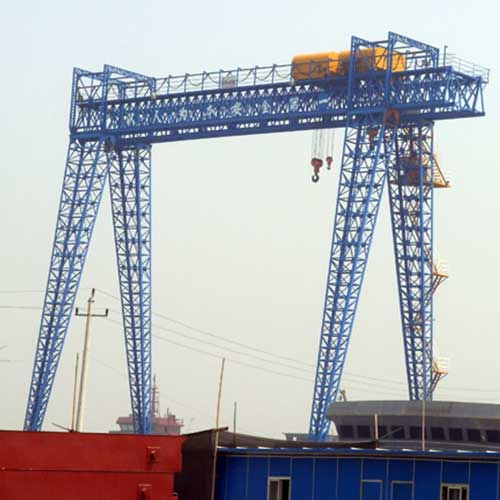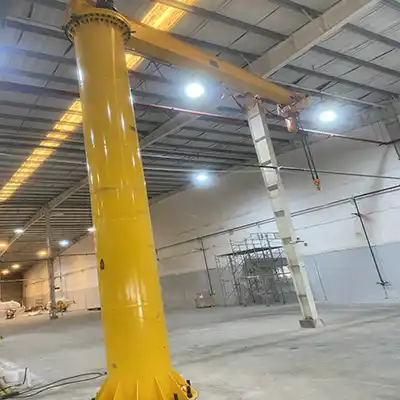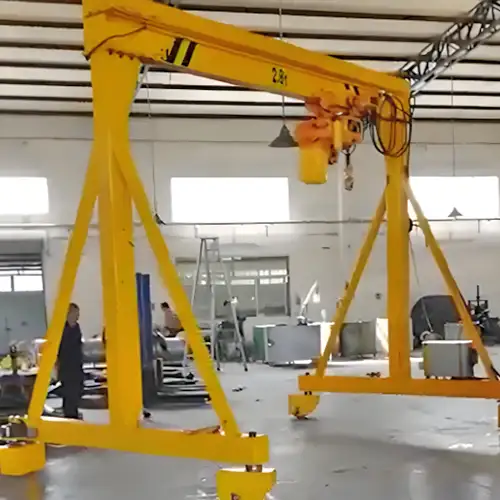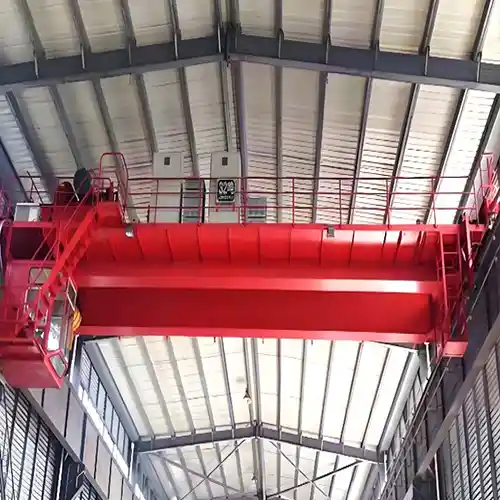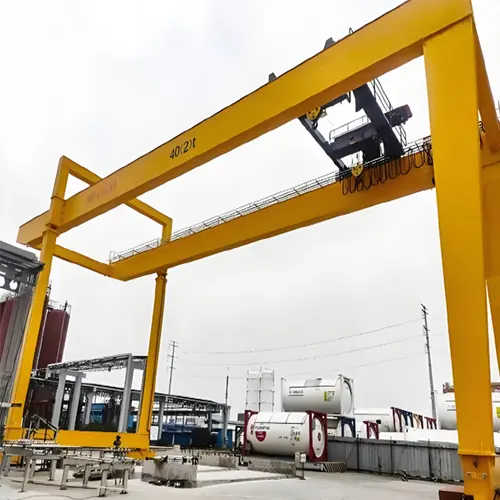Truss Girder Gantry Cranes in Shipyard Material Handling 50 to 200 Tons
Truss grider goliath crane & portal crane for heavy ship components, containers & heavy machinery at Shipyards, naval construction sites & marine logistics.
Category: Featured
Your Trusted Truss Girder Portal Gantry Crane Manufacturer & Supplier
Truss Girder Gantry Cranes in Shipyard Material Handling 50 to 200 Tons
Truss grider goliath crane & portal crane for heavy ship components, containers & heavy machinery at Shipyards, naval construction sites & marine logistics.
Truss Girder Gantry Cranes with Electric Hoist in Shipyard Material Handling
Truss Girder Gantry Cranes are widely used in the shipyard for material handling. The truss gantry cranes feature a distinctive truss girder configuration, characterized by their robust and lightweight design. This structural innovation provides exceptional strength while minimizing the overall weight, making them ideal for demanding applications like shipyard material handling.
Shipyard operations demand precision, strength, and adaptability in material handling equipment, and Truss Girder Gantry Cranes stand at the forefront of meeting these requirements. Their unique truss girder structure ensures stability even in challenging maritime environments, enabling efficient handling of heavy ship components, modules, and hulls.
Functionality of Truss Girder Gantry Cranes
- Vertical Reach and Lifting Capacity : The vertical reach of Truss Girder Gantry Cranes is a key factor in shipyard material handling. Their ability to lift heavy ship components to significant heights ensures efficient assembly, disassembly, and loading operations within the shipyard.
- Stability in Maritime Environments : The inherent stability of Truss Girder Gantry Cranes, even in the presence of saltwater and challenging weather conditions, sets them apart. This stability is crucial for maintaining operational safety during material handling tasks on ships and in shipyard storage yards.
Applications of Truss Girder Gantry Cranes
- Handling Heavy Ship Components: Truss Girder Gantry Cranes excel in the precise handling of heavy ship components, such as engines, sections, and structural elements. Their stability and lifting capacity make them indispensable for ship assembly and construction processes.
- Loading and Unloading Operations : Efficient loading and unloading of ships require cranes that can handle diverse loads and navigate varying heights. Truss Girder Gantry Cranes are designed to perform these operations with precision, ensuring smooth maritime logistics within the shipyard.
Types of Truss Girder Gantry Cranes Used in Shipyard
Truss Girder Gantry Cranes are characterized by their innovative truss girder configuration. This structural design features triangular trusses forming a grid like pattern, delivering exceptional strength and stability. The truss girder configuration ensures a balanced distribution of loads, making these cranes well suited for the dynamic and challenging conditions encountered in shipyards.
The triangular arrangement of trusses enhances the crane's resistance to torsional forces, allowing for precise and controlled movements during material handling operations. This design not only optimizes strength but also contributes to the crane's lightweight nature, a crucial factor in shipyard applications where versatility and efficiency are paramount.
Truss girder gantry cranes with electric hoists used in shipyards can be categorized into several main types based on their design and functionality. These types cater to different applications within the shipyard environment. Here are the main types:
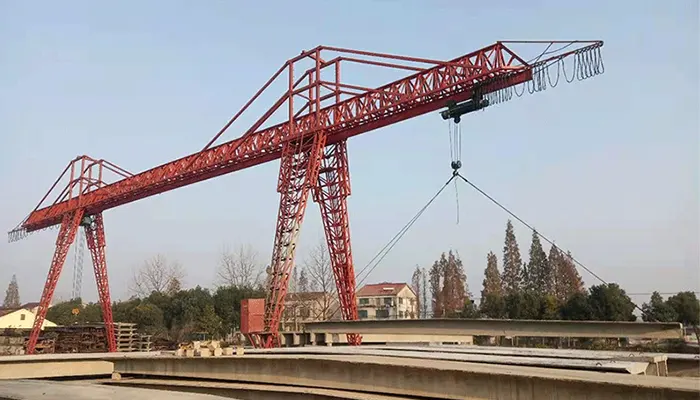
Single Girder Truss Gantry Crane:
- Design: This type of truss girder gantry crane features a single girder, which is a horizontal beam spanning the width of the crane.
- Truss Configuration: The crane incorporates a truss structure, utilizing triangular patterns for enhanced strength and stability.
- Functionality: Designed for handling lighter loads and providing flexibility in shipyard material handling operations.
Applications:
Lifting and positioning smaller ship components during construction.
Efficiently handling materials during ship maintenance tasks.
Versatile use for various material handling applications within the shipyard.
Benefits:
Lightweight design allows for agile and efficient movement.
Well suited for tasks that require precision and flexibility.
Cost effective solution for lighter load applications.
Considerations:
Ideal for smaller to medium sized shipyards or specific tasks within larger shipyard operations.
Well suited for tasks where maneuverability and adaptability are crucial.
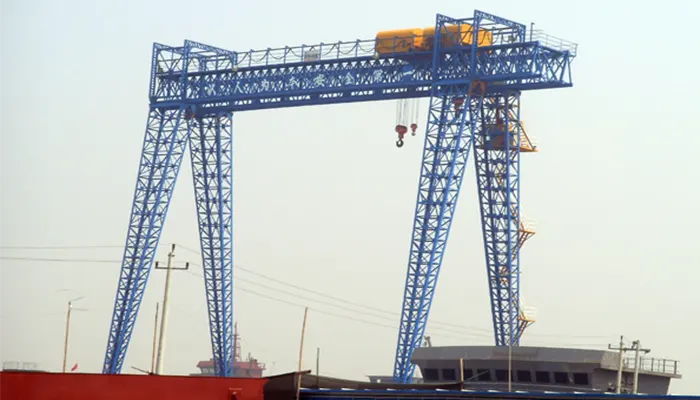
Double Girder Truss Gantry Crane:
- Design: This type of truss girder gantry crane is characterized by the presence of two horizontal girders spanning the width of the crane.
- Truss Configuration: Similar to the single girder variant, it utilizes a truss structure with triangular patterns for added strength and stability.
- Functionality: Engineered for handling heavier loads and providing increased stability, making it suitable for larger shipyard operations.
Applications:
Lifting and assembling large ship modules and sections during construction.
Efficient handling of heavy ship components, such as engines and structural elements.
Versatile use in shipyards with a focus on heavy duty material handling.
Benefits:
Higher lifting capacity and stability, making it ideal for larger and more complex shipbuilding tasks.
Well suited for applications where precision and control are essential.
Considerations:
Suitable for medium to large sized shipyards with heavier material handling requirements.
Provides robust performance in demanding shipbuilding and maintenance tasks.
Customized Truss Gantry Crane:
- Design: This type of truss girder gantry crane is specifically tailored to meet unique and specialized requirements within the shipyard.
- Truss Configuration: Adaptable truss structure designed to accommodate specific needs and tasks.
- Functionality: Engineered with specialized features, attachments, and configurations to address distinct material handling challenges in the shipyard.
Applications:
Handling and assembling unique ship components with non standard dimensions.
Specialized lifting tasks that require custom attachments or configurations.
Adapting to unconventional layouts or processes within the shipyard.
Benefits:
Tailored to meet specific shipyard needs, providing optimized solutions for unique challenges.
Enhanced efficiency and performance in handling non standard ship components.
Considerations:
Ideal for shipyards with distinct material handling requirements.
Requires detailed collaboration between the crane manufacturer and the shipyard to design a solution that precisely meets the intended purpose.
May involve higher initial costs due to customization but offers long term benefits in optimized functionality.
These types cover a range of lifting capacities, sizes, and functionalities, providing shipyards with options to choose the most suitable truss girder gantry crane based on their specific applications and operational requirements.
Materials Used in Construction Shipbuiling Gantry Cranes
The materials selected for constructing Truss Girder Gantry Cranes play a pivotal role in determining their durability, corrosion resistance, and overall performance in maritime environments. High strength alloys, such as aluminum or steel, are commonly utilized to ensure the crane's structural integrity and load bearing capabilities.
Corrosion resistant coatings further protect the crane from the harsh effects of saltwater and atmospheric conditions prevalent in shipyards. The choice of materials reflects a commitment to longevity and reliability, essential factors in shipyard material handling where equipment endurance is a key consideration.
The combination of the truss girder configuration and high quality construction materials positions these cranes as reliable assets in shipyards, capable of withstanding the unique challenges posed by marine environments.
Functionality
Vertical Reach:
Truss Girder Gantry Cranes are renowned for their impressive vertical reach, a crucial factor in shipyard material handling. The truss girder configuration, coupled with advanced engineering, allows these cranes to achieve significant lifting heights. This vertical reach is essential for tasks such as installing ship components, reaching different levels of vessels, and efficiently managing the assembly and disassembly of maritime structures.
The ability to extend vertically ensures that Truss Girder Gantry Cranes can adapt to the varying dimensions of ships and accommodate the specific requirements of shipyard operations. Ship components, regardless of size or weight, can be handled with precision, contributing to the overall efficiency of material handling tasks.
Lifting Capacity:
The lifting capacity of Truss Girder Gantry Cranes is a defining feature that makes them indispensable in shipyard environments. These cranes are engineered to handle heavy loads commonly encountered in ship construction and repair. The robust truss girder structure, combined with powerful electric hoists, empowers these cranes to lift and move ship components with ease.
Shipyard professionals can confidently maneuver and position substantial loads, such as ship modules, hull sections, and machinery components, with the assurance of the crane's high lifting capacity. This capability not only enhances operational efficiency but also contributes to the safety of material handling tasks within the shipyard.
Stability in Maritime Environments
The stability of Truss Girder Gantry Cranes in maritime environments is a critical aspect of their functionality. Shipyards are inherently exposed to saltwater, wind, and other challenging weather conditions. The truss girder design, known for its structural stability, ensures that these cranes remain steadfast even when subjected to the dynamic forces present in coastal and shipyard settings.
The robust construction and strategic placement of the truss girders contribute to the crane's resistance to torsional forces, minimizing swaying or oscillations during lifting and movement. This stability is essential for precise material handling tasks on ships, where accuracy and control are paramount.
Truss Girder Gantry Cranes not only navigate the vertical challenges of shipyard operations but also maintain steadfast stability in the face of maritime elements, making them a reliable choice for shipyard material handling.
Applications
Handling Heavy Ship Components
Truss Girder Gantry Cranes play a pivotal role in the efficient handling of heavy ship components within shipyards. The robust design, coupled with high lifting capacity, allows these cranes to lift and position substantial loads with precision. Ship components such as engines, sections, and structural elements are maneuvered seamlessly, contributing to the assembly and construction processes.
The truss girder configuration ensures that the crane can navigate the varying dimensions and weights of ship components, providing versatility in material handling. Whether it's placing a massive engine into a vessel or positioning a large hull section for assembly, Truss Girder Gantry Cranes excel in the careful and controlled handling of heavy ship components.
Loading and Unloading Operations
Efficient loading and unloading operations are paramount in shipyards, and Truss Girder Gantry Cranes are tailored for these tasks. The vertical reach and stability of these cranes make them ideal for reaching different levels of vessels, facilitating the movement of diverse loads.
- Efficient Container Handling: Truss Girder Gantry Cranes excel in handling containers, a common requirement in shipyards involved in cargo and logistics. The precise vertical reach allows for the seamless loading and unloading of containers from ships, optimizing the flow of materials within the shipyard.
- Bulk Material Handling for Ship Construction: In ship construction, where bulk materials like steel, machinery, and other components are crucial, Truss Girder Gantry Cranes demonstrate their adaptability. These cranes efficiently handle bulk materials during loading onto ships or unloading for assembly, ensuring a streamlined workflow.
The applications extend to various shipyard scenarios, making Truss Girder Gantry Cranes versatile assets for material handling operations. Their ability to handle heavy ship components and execute loading and unloading tasks with precision positions them as indispensable equipment in the maritime industry.
Electric Hoists for Truss Girder Gantry Cranes
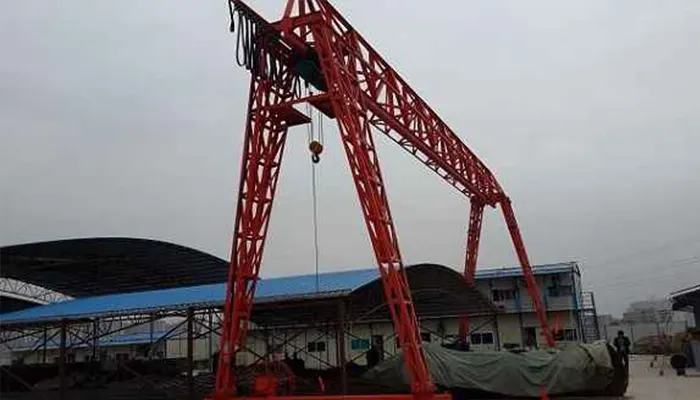
Wire Rope Hoists
Design and Structure
Robust Construction:
Wire rope hoists designed for Truss Girder Gantry Cranes feature robust construction to withstand the demanding conditions of shipyard material handling. High quality materials, such as galvanized steel, ensure durability and corrosion resistance, crucial for longevity in maritime environments.
Multi Layered Drum Design:
The drum design of wire rope hoists is engineered to accommodate multiple layers of wire rope. This feature optimizes the hoist's lifting capacity and ensures consistent performance, even when handling heavy ship components. The multi layered drum design enhances the hoist's versatility in various lifting scenarios within shipyards.
Functionality in Shipyard Material Handling
Precision Lifting:
Wire rope hoists provide precise and controlled lifting, a critical requirement in shipyard material handling. The smooth operation of the hoist allows for accurate positioning of heavy ship components during assembly, disassembly, and loading operations. This precision is instrumental in ensuring the safety and efficiency of material handling tasks.
Adaptability to Vertical Reach:
The design of wire rope hoists complements the vertical reach capabilities of Truss Girder Gantry Cranes. Whether lifting ship modules, machinery components, or hull sections to significant heights, wire rope hoists contribute to the crane's ability to adapt to the varying dimensions of vessels in shipyards.

Electric Crab Hoists
Design and Structure
Compact and Sturdy Build:
Double girder hoists utilized in conjunction with Truss Girder Gantry Cranes are characterized by their compact yet sturdy build. The design incorporates durable components, including load chains and hooks, ensuring reliability in maritime environments. The compact nature of chain hoists enhances the overall agility of the crane in material handling tasks.
Ease of Maintenance:
Electric Crab Hoists are designed with simplicity and ease of maintenance in mind. The modular components are accessible for inspection and servicing, facilitating efficient maintenance routines in shipyard settings. This feature contributes to the longevity of the hoist and reduces downtime for maintenance activities.
Suitability for Maritime Environments
Corrosion Resistance:
Chain hoists are engineered with materials and coatings that provide resistance to corrosion, a crucial factor in shipyards exposed to saltwater and harsh atmospheric conditions. This ensures the longevity and reliability of chain hoists, even in the challenging maritime environment.
Versatile Load Handling:
Chain hoists offer versatility in handling various loads encountered in shipyard operations. From lifting heavy machinery to maneuvering ship components during loading and unloading, the adaptability of chain hoists complements the diverse material handling requirements within shipyards.
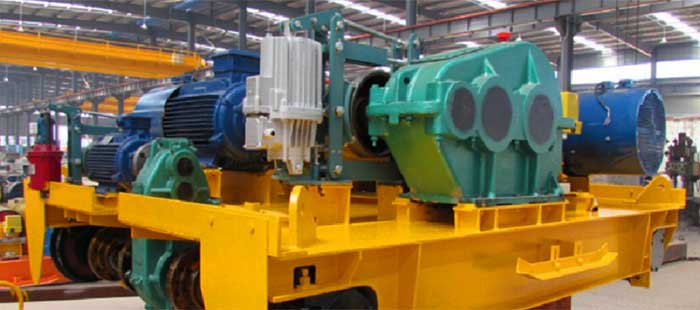
Open Winch Hoist for Truss Girder Gantry Cranes
An open winch hoist for a truss gantry crane typically refers to the mechanism responsible for lifting and lowering loads on the crane. This type of hoist is commonly used in industrial settings, construction sites, and warehouses for moving heavy objects.
Here are some key features and considerations for an open winch hoist used in a truss gantry crane:
- Capacity: The hoist's capacity should match the maximum load requirements of the crane. It's essential to ensure that the hoist can safely lift the intended loads without exceeding its rated capacity.
- Design: An open winch hoist typically features an open frame design, allowing for easy access to the internal components for maintenance and inspection. This design also reduces the overall weight of the hoist, making it easier to install and maneuver.
- Motor: The hoist is powered by an electric motor, which provides the necessary lifting force. Depending on the application, you may choose between different motor types, such as AC or DC motors, to suit the specific requirements of the crane.
- Hoisting Speed: The hoist should have adjustable hoisting speeds to accommodate various load sizes and lifting requirements. Variable speed controls allow for precise positioning of loads and increased productivity.
- Safety Features: Safety is paramount when operating a crane. The hoist should include safety features such as overload protection, emergency stop buttons, and limit switches to prevent accidents and protect both personnel and equipment.
- Durability and Reliability: The hoist should be constructed from high-quality materials to ensure durability and reliability in demanding environments. Components such as gears, brakes, and bearings should be robust enough to withstand continuous use and heavy loads.
- Control System: The hoist's control system should be user-friendly and intuitive, allowing operators to easily maneuver and control the crane. Remote control options may also be available for added convenience and flexibility.
- Compliance: Ensure that the hoist complies with relevant safety standards and regulations in your region, such as OSHA (Occupational Safety and Health Administration) regulations in the United States or CE (Conformité Européenne) standards in Europe.
When selecting an open winch hoist for a truss gantry crane, it's essential to consider the specific requirements of your application, including load capacity, operating environment, and safety standards, to choose the most suitable option. Additionally, regular maintenance and inspections are crucial to ensure the continued safe and efficient operation of the hoist and crane system.
Outdoor Applications in Shipyard Material Handling

Handling Ship Components
Ship Modules and Sections
Truss Girder Gantry Cranes, specifically designed for outdoor applications in shipyards, excel in handling various ship components. When it comes to ship modules and sections, these cranes provide unmatched versatility and precision. The robust truss girder configuration, combined with powerful electric hoists, allows for the efficient lifting and positioning of ship modules, ensuring seamless assembly processes.
Key Features:
Adaptive Lifting: The truss girder design enables the crane to adapt to the diverse shapes and sizes of ship modules and sections, providing flexibility in material handling tasks.
Optimized Vertical Reach: The vertical reach of Truss Girder Gantry Cranes ensures that ship modules can be lifted to significant heights, accommodating the varying configurations of vessels under construction.
Ship Hulls and Superstructures
Truss Girder Gantry Cranes play a crucial role in the construction of ship hulls and superstructures in outdoor shipyard environments. The robust design and stability of these cranes contribute to the careful handling of large and heavy components involved in ship construction.
Key Features:
Steadfast Stability: The truss girder configuration ensures stability during the lifting and positioning of substantial ship hulls and superstructures, minimizing swaying or oscillations.
Precision Maneuvering: Electric hoists, whether wire rope or chain, provide precise control over the movement of ship components, allowing for accurate placement during assembly.
Loading and Unloading Ships
Efficient Container Handling
Truss Girder Gantry Cranes are adept at efficiently handling containers during the loading and unloading of ships in outdoor shipyard settings. The vertical reach and lifting capacity of these cranes make them ideal for reaching different levels of vessels, facilitating the organized movement of containers.
Key Features:
Swift Vertical Movement: The vertical reach of the crane ensures quick and efficient container handling, optimizing the loading and unloading processes.
Versatile Container Sizes: The adaptability of Truss Girder Gantry Cranes allows them to handle containers of various sizes, contributing to the versatility of container operations in shipyards.
Bulk Material Handling for Ship Construction
In ship construction, bulk material handling is a critical aspect, and Truss Girder Gantry Cranes are tailored for the efficient movement of bulk materials in outdoor environments. Whether it's transporting steel, machinery, or other components, these cranes contribute to a streamlined workflow.
Key Features:
Adaptability to Bulk Materials: Truss Girder Gantry Cranes, equipped with suitable electric hoists, adapt to the handling of diverse bulk materials, ensuring flexibility in ship construction operations.
Sturdy Construction: The robust truss girder design and corrosion resistant materials ensure the durability and longevity of the crane, even when exposed to the challenges of outdoor shipyard environments.
Indoor Applications in Shipyard Material Handling
Assembly and Disassembly of Ship Components
Installing Ship Engines and Equipment
Box Girder Gantry Cranes prove indispensable in shipyard workshops for the precise assembly of ship engines and equipment. The indoor environment allows for controlled conditions, ensuring the accuracy and safety of the installation process. The box girder design, coupled with electric hoists, facilitates the lifting and placement of heavy ship components with precision.
Key Applications:
Engine Placement: Box Girder Gantry Cranes are used for carefully lifting and installing ship engines into vessels, ensuring a secure and accurate fit.
Equipment Integration: The cranes play a vital role in the integration of various ship equipment, such as propulsion systems, navigation instruments, and auxiliary machinery.
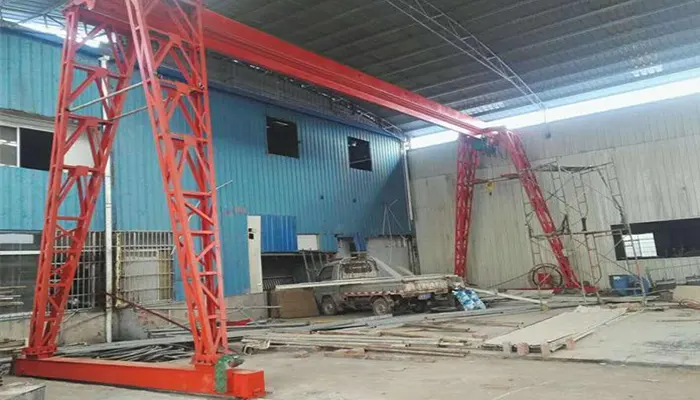
Breaking Down Decommissioned Ships
In shipyard facilities dedicated to ship decommissioning or refurbishment, Truss Girder Gantry Cranes are employed for the controlled disassembly of decommissioned ships. The indoor setting allows for systematic deconstruction, salvaging valuable components, and ensuring environmentally responsible ship recycling.
Key Applications:
Sectional Disassembly: The truss girder configuration enables the controlled disassembly of decommissioned ships into manageable sections for efficient salvage and recycling.
Component Removal: Electric hoists assist in the careful removal of ship components, ensuring that reusable parts are salvaged while adhering to safety and environmental standards.
Storage and Retrieval in Shipyard Warehouses
Organizing Ship Parts Inventory
Truss Girder Gantry Cranes play a crucial role in shipyard warehouses where the organization of ship parts inventory is paramount. The indoor environment allows for systematic storage, retrieval, and inventory management, ensuring that essential ship components are readily accessible.
Key Applications:
Vertical Storage Access: The vertical reach capabilities of the crane facilitate organized storage in vertical racks, optimizing the warehouse space.
Efficient Retrieval: Electric hoists contribute to the swift and precise retrieval of ship parts, reducing downtime in maintenance and construction processes.
Managing Spare Parts and Equipment
Shipyard warehouses often house a vast inventory of spare parts and equipment. Truss Girder Gantry Cranes, operating indoors, provide the necessary material handling capabilities for efficiently managing and organizing spare parts, ensuring they are readily available when needed.
Key Applications:
Selective Retrieval: Electric hoists allow for selective retrieval of spare parts, minimizing the time required to locate and access specific components.
Inventory Rotation: The cranes facilitate the rotation of inventory, ensuring that spare parts are regularly inspected and maintained for optimal functionality.
Specialized Features for Shipyard Material Handling
Corrosion Resistance
Shipyard environments pose unique challenges due to exposure to saltwater and harsh atmospheric conditions. Truss Girder Gantry Cranes with a focus on corrosion resistance ensure longevity and reliable performance in these demanding settings.
Key Considerations:
Material Selection: Opt for cranes constructed with corrosion resistant materials, such as stainless steel or galvanized components, to withstand the corrosive effects of saltwater.
Protective Coatings: Choose cranes with specialized coatings that provide an additional layer of protection against corrosion, ensuring the longevity of the equipment.
Enhanced Weatherproofing
Given the outdoor applications of Truss Girder Gantry Cranes in shipyards, enhanced weatherproofing features are essential. These features ensure the crane's resilience against adverse weather conditions, including rain, wind, and extreme temperatures.
Key Considerations:
Sealed Components: Select cranes with sealed and weatherproof components to prevent water ingress and protect internal mechanisms from environmental factors.
Weather Resistant Paint: Cranes with weather resistant paint or finishes contribute to protecting the structure from the effects of prolonged exposure to sunlight, rain, and salt laden air.
Advanced Control Systems for Maritime Precision
Precision and control are paramount in shipyard material handling tasks. Truss Girder Gantry Cranes equipped with advanced control systems enhance maritime precision, allowing for accurate and efficient operations.
Key Considerations:
Variable Frequency Drives (VFDs): Cranes with VFDs offer precise control over lifting and movement, allowing for gradual acceleration and deceleration, reducing stress on components.
Positioning Systems: Advanced positioning systems, such as load sway control and anti sway features, contribute to the precise placement of heavy ship components, ensuring safety and efficiency.
Considerations for Truss Girder Gantry Crane Buyers in Shipyards
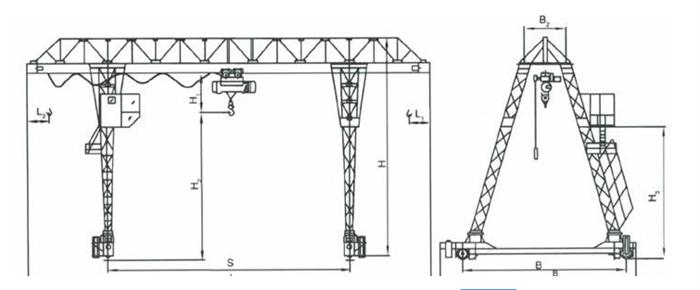
Load Capacity and Vertical Reach Requirements
Load Capacity
Evaluate the specific load requirements of your shipyard operations. Consider the weight of ship components, engines, and equipment that the Truss Girder Gantry Crane will handle. Ensure the crane's load capacity aligns with the heaviest loads encountered in your shipyard.
Key Considerations:
Maximum Load Weight: Determine the maximum weight of ship components or materials that the crane needs to lift.
Future Expansion: Anticipate potential changes in load requirements due to larger vessels or heavier components in the future.
Vertical Reach
Assess the vertical reach needed for efficient material handling within the shipyard. Consider the height of ship modules, hulls, and superstructures that the crane must lift. Ensure the crane's vertical reach accommodates the full range of lifting requirements.
Key Considerations:
Shipyard Layout: Evaluate the layout of shipyard facilities to determine the required vertical reach for seamless material handling.
Optimal Vertical Clearance: Consider the maximum height clearance needed for lifting and positioning ship components without obstruction.
Adaptability to Shipyard Layouts
Maneuverability
Evaluate the maneuverability of the Truss Girder Gantry Crane within the shipyard. Consider the available space, aisles, and the need for precise navigation to optimize material flow.
Key Considerations:
Rail Systems: Determine whether the crane will operate on fixed rails, allowing for controlled movement along specific paths within the shipyard.
Portability: If portability is essential, choose cranes with designs that facilitate easy relocation within the shipyard layout.
Spatial Considerations
Consider the spatial constraints and layout intricacies of the shipyard. Ensure the crane's design aligns with the available space, allowing for efficient material handling without causing congestion or disruptions.
Key Considerations:
Turning Radius: Assess the crane's turning radius to navigate through tight spaces and corners in the shipyard.
Clearance Requirements: Ensure that the crane's structure provides adequate clearance to maneuver safely within the shipyard environment.
Integration with Existing Shipyard Equipment
Compatibility
Ensure the Truss Girder Gantry Crane seamlessly integrates with existing shipyard equipment. Compatibility with other material handling machinery, storage systems, and auxiliary equipment enhances overall operational efficiency.
Key Considerations:
Communication Systems: Verify that the crane's control systems can communicate with other equipment for synchronized operations.
Interoperability: Choose a crane that integrates with common industry standards to facilitate compatibility with various shipyard equipment.
Automation Features
Consider the level of automation and integration capabilities offered by the crane. Automation can enhance overall efficiency by enabling coordinated material handling processes in conjunction with other equipment.
Key Considerations:
Smart Systems Integration: Explore cranes with smart systems that can be integrated into broader shipyard management and automation systems.
Data Exchange: Ensure compatibility for data exchange between the crane and other equipment to streamline operations.
Safety Features for Maritime Environments
Environmental Resilience
Prioritize safety features that enhance the crane's resilience in maritime environments. Shipyards are exposed to saltwater, changing weather conditions, and potential corrosive elements, requiring the crane to withstand these challenges.
Key Considerations:
Corrosion Resistance: Choose materials and coatings that resist corrosion, ensuring the crane's structural integrity in saltwater environments.
Weatherproofing: Select cranes with weatherproofing features to protect internal components from the effects of rain, wind, and temperature variations.
Operator Safety
Prioritize features that enhance operator safety during material handling operations. This includes mechanisms to prevent load sway, emergency stop systems, and comprehensive safety protocols.
Key Considerations:
Load Sway Control: Opt for cranes equipped with load sway control to minimize swinging and ensure precise load positioning.
Emergency Stop Systems: Ensure the crane is equipped with emergency stop systems that provide immediate halting in case of unforeseen circumstances.
Maintenance and Lifecycle Considerations
Regular Inspection and Maintenance Protocols
- Scheduled Inspections: Establish a routine inspection schedule to assess the condition of critical components, ensuring that wear and tear are promptly identified and addressed.
- Preventive Maintenance: Implement preventive maintenance measures, such as lubrication of moving parts and regular system checks, to enhance the longevity and reliability of the crane.
Longevity of Truss Girder Gantry Cranes in Marine Environments
- Quality of Construction: Prioritize cranes from reputable manufacturers known for producing high quality, durable equipment suitable for marine environments.
- Corrosion Protection Measures: Invest in cranes with effective corrosion protection measures, including coatings and materials designed to withstand the corrosive effects of saltwater.
Operator Training and Safety Measures
Specialized Training for Shipyard Crane Operators
- Comprehensive Crane Operation Training: Ensure that operators receive specialized training in the operation of Truss Girder Gantry Cranes specific to shipyard material handling. Training programs should cover crane controls, load handling techniques, and emergency procedures.
- Maritime Safety Regulations: Equip operators with knowledge of maritime safety regulations and guidelines to navigate and operate cranes in compliance with industry standards. This includes understanding the unique challenges of shipyard environments.
Safety Protocols in Shipyard Material Handling
- Adherence to Safety Guidelines: Establish and enforce strict adherence to safety guidelines during all material handling operations. This includes the use of personal protective equipment (PPE) and compliance with safety protocols designed for shipyard environments.
- Emergency Response Training: Conduct regular emergency response training for crane operators to ensure swift and effective responses to unforeseen situations. This training should cover procedures for equipment malfunction, inclement weather, or other emergency scenarios.
- 3. Collaboration with Safety Personnel: Foster collaboration between crane operators and safety personnel to create a safety conscious work environment. Encourage open communication regarding safety concerns and the reporting of any incidents promptly.
Cost Analysis and Return on Investment in Shipyard Operations
Initial Investment Considerations
- Capital Expenditure: Evaluate the initial investment required for acquiring and installing Truss Girder Gantry Cranes in the shipyard. Consider the crane's load capacity, features, and any additional customization required.
- Installation Costs: Factor in the costs associated with the installation of the crane, including any modifications needed in the shipyard infrastructure to accommodate the new equipment.
Operational Cost Efficiency
- Energy Efficiency: Assess the energy consumption of the crane and opt for models with energy efficient features. Consider how these features can contribute to long term operational cost savings.
- Maintenance Costs: Analyze the expected maintenance costs over the crane's lifecycle. Choose cranes with a reputation for reliability and minimal maintenance requirements to optimize operational efficiency.
Evaluating Long Term Value for Shipyard Operations
- Projected Lifespan: Consider the projected lifespan of the Truss Girder Gantry Cranes and assess how well the equipment aligns with the long term needs of the shipyard.
- Productivity Gains: Evaluate the potential productivity gains and operational efficiency improvements that the crane can bring to shipyard material handling tasks. Consider how these gains contribute to the long term value of the investment.
Conclusion: Custom Truss Girder Goliath Cranes
In this comprehensive guide, we have navigated through the essential aspects of Truss Girder Gantry Cranes with electric hoists for shipyard material handling. Key points covered include the design and structure of these cranes, their functionality, applications both indoors and outdoors, specialized features for maritime environments, and considerations for buyers in shipyards.
Final Recommendations for Truss Girder Gantry Crane Buyers in Shipyards
- Prioritize Safety: When selecting Truss Girder Gantry Cranes for shipyard operations, prioritize safety features and adherence to maritime regulations to ensure the well being of operators and the longevity of the equipment.
- Customization for Shipyard Layouts: Opt for cranes that can be customized to suit the specific layout and constraints of the shipyard, enhancing maneuverability and efficiency in material handling processes.
- 3. Evaluate Long Term Value: Consider the projected lifespan and long term value that Truss Girder Gantry Cranes bring to shipyard operations. Assess their contribution to productivity gains and overall operational efficiency.
Encouragement for Continuous Improvement in Shipyard Material Handling
As technology evolves, shipyards are encouraged to stay abreast of emerging trends and innovations in material handling equipment. Continuous improvement in operational processes, safety protocols, and the adoption of advanced technologies ensures that shipyards remain at the forefront of efficiency and productivity.
Main Projects
Related Products

Supplied three grab bucket crane kits to Indonesia, enhancing garbage handling efficiency with high load capacity and reliable performance.
Free consultation to Confirm Parameters & Specifications and Get
Latest Crane Price & Crane Rate.
- Types of overhead cranes : _______?
- Optional: Overhead travelling crane, goliath gantry crane,Slewing jib crane, Single girder or double girder crane,small portable crane or kbk crane, etc.
- Capacity of overhead crane: _______?
- Optional: 0.25ton, 0.5 ton, 1 ton, 2 ton, 3ton, 5 ton, 10 ton,15ton, 20ton, 25 ton, 30ton,35ton, up to 550ton, etc.
- Crane span & lifting height : _______?
- Crane travelling length : _____?
- Control of overhead crane:_______?
- Optional: pendant/ remote/cabin control
- Voltage supply of overhead crane:_____?
- Eg,: 380V50/60HZ,3Phase or others,etc.
- Application/usage of crane:_______?
- Eg,: Steel mill, ,injection mold, cement,stone, concrete,granite, general manufacturing, etc.
Just leave a message via the contact form and our hoist and crane engineer will contact you with in 24working hours.
Get In Touch
